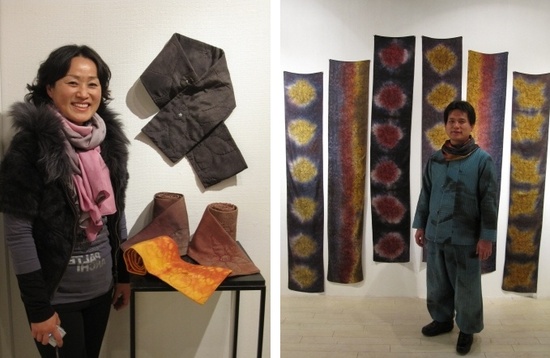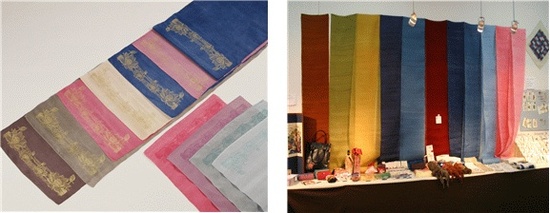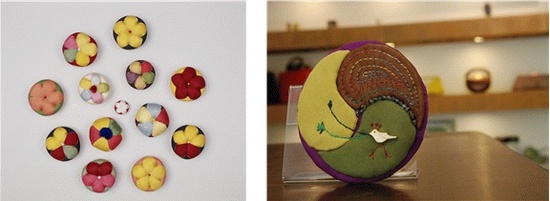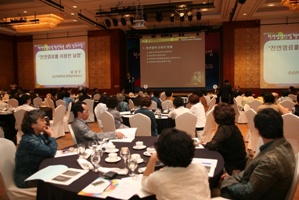This is real! The world of natural dyes
On January 11, Maronie exhibition in Kyoto.
Gyeongnam Natural Dyeing Association in Korea held a six-day exhibition in Kyoto which is said to be a city of vivid traditional culture of Japan. Nine members of Gyeongnam Natural Dyeing Association introduced various kinds of natural dyeing products that were made with passion, which received favorite comments from not only Japanese but also the same industry. Let’s take a closer look at this globally recognized and beautiful field of natural dyeing.

< Gyeongbuk Natural Dyeing Association declared that it will become a Mecca of the natural dyeing after hosting ‘Symposium for the Vitalization of the Natural dyeing Industry’ last June.> (Photograph: Fashion Journal)
Natural dyes, the solution of Health and environment
In the Three Kingdom period, while the kings and nobles wore the silk costumes which were imported from China, commoners began to dress themselves with the naturally-dyed clothes. At the beginning, they used grass and polygonum indigo from mountains and fields for navy, persimmon for dark blue, and charcoal for black. In other words, Korean ancestors wear the nature colored clothes, which are different from the recent clothes with unnatural colors made of the artificial fibers and chemical compounds.
Actually, the naturally-dyed clothes do good to skin. Some clothes with chemical dyes cause an atopic dermatitis or other skin diseases to some children who have a delicate skin. However, considering the fact that natural dyes from vegetables are harmless to human and kill the harmful virus, it can be said that clothes save our health.
While the chemical dyes cause serious environmental problems with waste water in dyeing process, natural dyes reduce those damage, which can be said an environmental-friendly dyeing method. In addition, if we make clothes with natural dyes which are extracted from the plants that have unique ingredients or smells to protect them from the harmful insects or animals, it will also protect your body from those. As an example, some ancestors used polygonum indigo as a dyeing material from their knowledge that snakes dislike its smell. Their wisdom of life is just amazing!

< Exhibition of Gyeongnam Natural Dyeing Association in Kyoto. Muffler(left) by Lee Kyung-ran, representative and printed scarf by You Chang-ho, the chairman of the association> (Photograph: Fashion Journal)
Despite the time and hard work, considered a ‘Must Try’ among foreigners
Then, what is the process of making such a wonderful natural dye? The beautiful naturally-dyed cloth can be born only after passing through the 20 manual labor steps, such as boiling, drying, and adding mordant in it. Mordant is an ingredient which helps the color last longer. As it requires a long time and hard work, accordingly the costs rise and become more expensive than the artificial colored-one.
However, as the public interests on environmentally-friendly products increase, the ideas on those products are also rapidly changing. In particular, the experiencing event of natural-dyeing became very popular among foreigners. Moreover, many naturally-dyed clothes are being sold in Jongro area, including Insadong, where foreign visitors mostly visit, and the number of foreigners who come and try the events from a word of mouth also increases. It is said that every single Japanese tourist who is said to have a lot interests on beauty are also impressed with Korea’s naturally-dyed products. It shows that natural dyeing can be worth being one of the representative brands in Korea. That seems enough to enter the global market, considering the Kyoto exhibition which introduced naturally-dyed products at the first on the list.

<Various naturally-dyed products>
Korean central government and local government which early saw the potentials have prepared the systematic supporting plan to step forward. Since when the natural dyeing industry was selected by the Ministry of Knowledge Economy as a nurturing business of the local government’s laboratory last 2008, the government finished the preparation to make Gyeongnam Natural Dyeing Association as a core center for natural dyeing industry, and now they are working on it for the development of the field. On the following, ‘Symposium for the Vitalization of the Natural dyeing Industry’ was held in June 2011, and the MOU with Daegu and Gyeongbuk fabric fashion Institute was embedded as well, which actively promotes the natural dyeing industry.

<Various household items made of natural dyes>
Indigo and dark blue, those colors make people relaxed. If we wear the naturally-dyed clothes, we can definitely say it is a well-being life. Now we all hope that Korea’s naturally-dyed products will actively pushing the overseas markets.
* This article refers to the article written by the communicator of the Presidential Council on Nation Branding
No comments:
Post a Comment